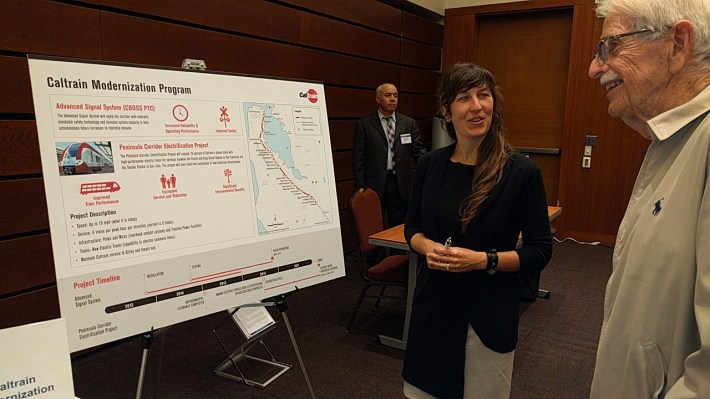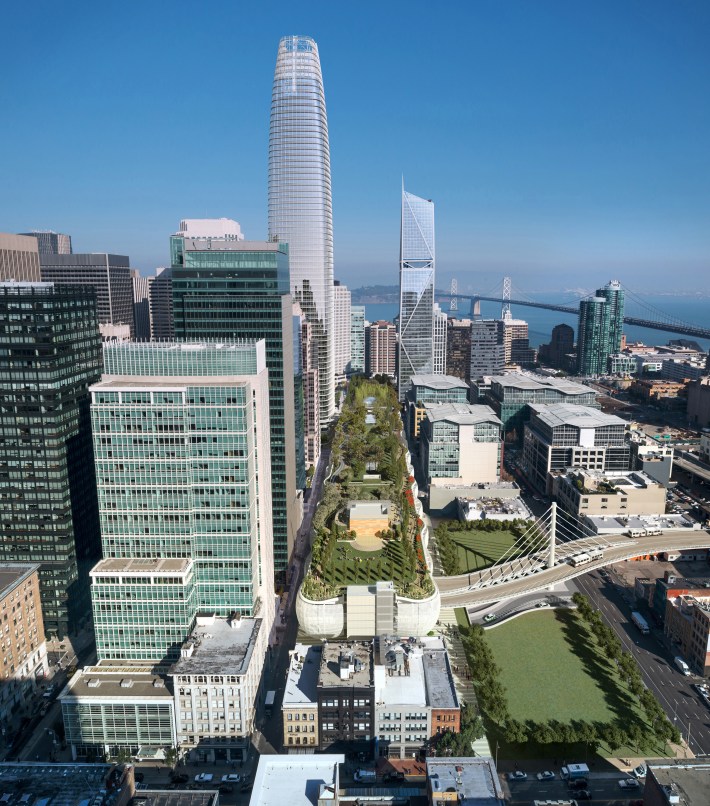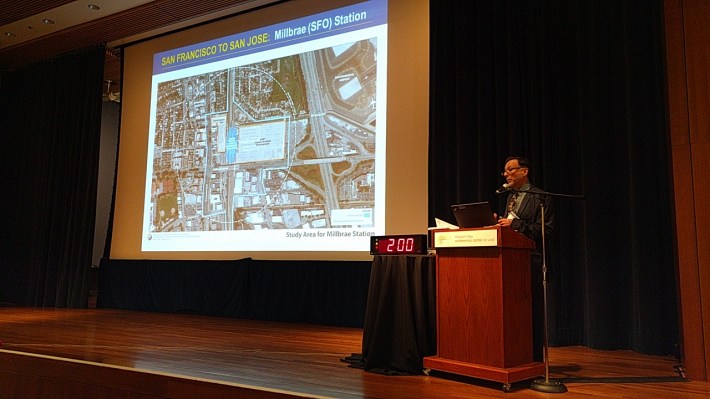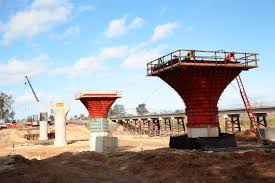
Monday evening the California High Speed Rail Authority, in conjunction with Caltrain, held a scoping meeting at the William J. Rutter Center at UCSF in Mission Bay. They answered public questions and took comment on plans to electrify Caltrain and bring high-speed trains from Bakersfield to San Francisco by 2029.
Streetsblog readers will recall that a few months ago the California-High Speed Rail Authority released a revised plan to link up Northern California to the Central Valley spine (which is already under construction). This meeting was one of a series to prepare the environmental reports for this next phase of construction.

The meeting started at 5:30, with members of the public invited to visit local information stations to ask questions about the projects. Casey Fromson, a government affairs officer for the Caltrain Modernization Program, was at the Caltrain information station. She explained that electrification of Caltrain, which, if all goes according to plan, should be completed in 2021, will offer faster service because of the better acceleration of electric trains. "A trip that our current, diesel baby bullets do in 60 minutes will take 45 with a train of electrics," she explained. Still, it was disappointing to learn that Caltrain won't be exploiting the top speed capabilities of its new electric fleet, which will start arriving in 2020. Although the trains will be capable of 110 mph, the tracks will only be able to handle about 80, because of the curves and the number of grade crossings. Getting the line up to full speed will have to wait for another round of improvements, such as adding more passing tracks, eliminating more grade crossings, and building more gradual curves, changes that will only come with the HSR project in 2029.
Brian Stokle, with the group "Friends of the DTX," [the "downtown extension" of Caltrain to the Transbay Terminal] was among the visitors. He expressed disappointment at the lack of progress in connecting Caltrain to Transbay, currently under constructions. "There's no true political champion for it yet. And it's a lot of money," he said. That was a concern echoed by others at the meeting.

During the presentation phase of the meeting, Ben Tripousis, the Northern California Regional Director for California HSR, went over the history of the project:
In 2008, the voters passed Proposition 1A, which paved the way for developing HSR service. We’re now at a point where we’re looking to move forward with the first revenue service. I’m happy to say it’s coming to Northern California. That was facilitated by the 2016 business plan which was released earlier this year and approved by the HSR board. It laid out a road map for completing service to the Bay Area. What makes the 2016 business plan different from 2012 or 2014 is it...lays out how we can construct revenue service with the $20.7 billion we already have. It will run from downtown San Francisco to downtown Bakersfield.
He then played a video that showed the six construction areas where work is currently underway, near Fresno and Madera. Bruce Fukuji, an Architect, City Planner and Urban Designer, talked about station planning for the alignment from San Jose to San Francisco. He spoke about the Millbrae Station, next to SFO:
We’ve been looking at examples around the world. We want global travelers arriving to SFO to immediately be able to get onto the HSR service and get to destinations throughout California. Part of the challenge is to take advantage of the inter-modal connectivity: BART, Caltrain and freeway access. How do we integrate all that? We're trying to work with the City of Millbrae on their Transit Oriented Development plans.

He also spoke about plans to integrate HSR at 4th and King and to help re-arrange Townsend so that bicycle, car-hailing, and bus service access to the station is improved. And that returned the conversation to the concerns of Stokle and others about the lack of progress on the DTX project. It was as if the HSR planners are already assuming the Transbay connection would not be completed in time--and that they would have to depend on King Street Station as its access point to San Francisco.
Esther Stearns of the SF Transit Riders spoke during the official public comment period: "We would urge you to aggressively address the downtown extension in the environmental reports--we want DTX in the EIR. We want to see access to the station in downtown rather than farther out," she said. Gerald Cauthen, co-founder of the Bay Area Transportation Working Group and SaveMuni (and a contributor to Streetsblog), also spoke: "I’d like to ask about capacity of the line [from San Jose to SF]. It’s now planned for ten trains an hour--six for Caltrain and four for HSR. Is that adequate? And how many years out do you go, and if there are constraints on that capacity, what is the constraint?"

There is an additional scoping meeting tonight, Tuesday, in San Mateo at the Marriott, from 5 to 8 p.m. at 1770 S. Amphlett Blvd., San Mateo, and another on Wednesday in Mountain View, at the SFV Lodge, also from 5 to 8 p.m., at 361 Villa St., Mountain View.





